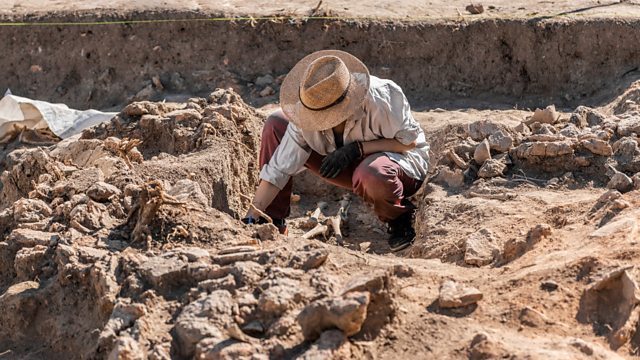Why does ancient stuff get buried?
Digging and excavating are bywords for archaeology; all over the world, we find traces of ancient civilisations under our feet. But why how does our history end up underground?
Digging and excavating are bywords for archaeology. But why does history end up deep under our feet?
This question struck CrowdScience listener Sunil in an underground car park. Archaeological remains found during the car park’s construction were displayed in the subterranean stairwells, getting progressively older the deeper he went. How had these treasures become covered in so much soil over the centuries?
CrowdScience visits Lisbon, the capital of Portugal – and home to the above-mentioned multi-storey car park. The city has evidence of human habitation stretching back into prehistory, with remnants of successive civilisations embedded and jumbled up below today’s street level. Why did it all end up like this?
Human behaviour is one factor, but natural processes are at work too. Over at Butser Ancient Farm, an experimental archaeology site in the UK, we explore the myriad forces of nature that cover up – or expose - ancient buildings and artefacts over time.
Contributors:
Dr Mariana Nabais, University of Lisbon
Carolina Grilo, Lisbon Museum of the Roman Theatre
Dr Matt Pope, University College London
Presented by Marnie Chesterton, Produced by Cathy Edwards for the Βι¶ΉΤΌΕΔ World Service.
IMAGE: Getty Images
Last on
More episodes
Clip
-
![]()
How a Neanderthal cave was saved from the sea
Duration: 02:12
Broadcasts
- Fri 20 May 2022 19:32GMTΒι¶ΉΤΌΕΔ World Service except East and Southern Africa & West and Central Africa
- Sat 21 May 2022 01:32GMTΒι¶ΉΤΌΕΔ World Service Europe and the Middle East
- Sun 22 May 2022 01:32GMTΒι¶ΉΤΌΕΔ World Service East and Southern Africa & West and Central Africa only
- Mon 23 May 2022 03:32GMTΒι¶ΉΤΌΕΔ World Service Australasia, South Asia & East Asia only
- Mon 23 May 2022 04:32GMTΒι¶ΉΤΌΕΔ World Service Americas and the Caribbean
- Mon 23 May 2022 08:32GMTΒι¶ΉΤΌΕΔ World Service
- Mon 23 May 2022 12:32GMTΒι¶ΉΤΌΕΔ World Service except East and Southern Africa, East Asia, South Asia & West and Central Africa
- Mon 23 May 2022 19:32GMTΒι¶ΉΤΌΕΔ World Service East and Southern Africa & West and Central Africa only
Podcast
-
![]()
CrowdScience
Answering your questions about life, Earth and the universe



